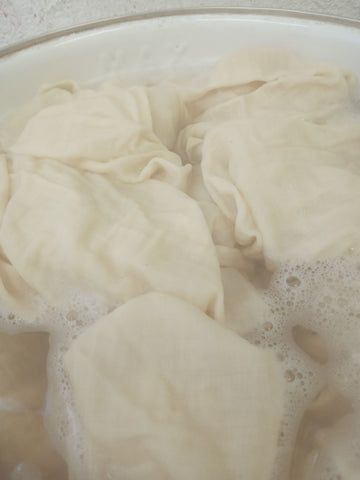How to mordant linen and cotton fabrics successfully
I have received a lot of emails the last couple of weeks, asking about how to mordant linen and cotton fabric. After repeatedly answering the same question over and over again, I thought why not post it on the blog?
There are several different methods of mordanting cellulose fibres, but I found the following technique the most practical. Many other recipes require Alum acetate, which I personally avoid using. I like to use what I have at hand and this recipe works a treat. Keep in mind that you will need time. This can be done within 4-5 hours or over a couple of days.
You can find a tip section at the end of this article - a shorter version of the text below.
There are several different tannin rich plants that can be used, each slightly different from the next. Tannin will always leave some colour behind. Tara is the lightest tannin with a light beige, followed by Oak Gall. Myrobalan, pomegranate are leaving yellow backgrounds. Another little trick - if you add your fabric to a 2-5% iron after bath, your fabric will turn grey to dark grey/black/purple once it has been mordanted with a tannin rich dye. If that is the colour you require - leave out the Alum/Soda Ash Step. Alum brightens dyes, which might result in steely purple.
Before we start, if you want to dye your fabric with Indigo - no mordanting is required. You only need to scour your fabric.

A mineral Indigo Vat
Scouring
Before (left) and after (right) scouring single layered organic cotton
Equipment
-
A pot big enough to hold your fabric
-
1 tsp of Soda Ash (or 1% of w.o.f.( w.o.f. stands for weight of fibre))
-
1/2 -1 tsp of organic washing up liquid
- Heat resistant rubber gloves
Mordanting cellulose fabrics successfully.
A 2 step process, please read through the entire instructions first.
Step 1:
Ingredients:
10-60% Tannin rich plant like Myrobalan (10% of the weight of fabric (w.o.f.)) other options would be Oak Gall, Sumac and Tara and any other source of tannin.

1.Fill a plastic or stainless steel vessel with cold water (40degrees Celsius/104F max) to a 30:1 ratio (water:fabric)
2. Add tannin and stir until dissolved or evenly distributed, ( I use a blender)
3. Add fabric, immerse fully for at least 1-2 hours up to 24h. Stir occasionally.
4. Use rubber gloves when removing fabric, squeeze fabric. Let it drip. Do not rinse! Tannin is bound to the fibre only by affinity and can be removed if rinsed aggressively.
5. Save mordant for future use.
6. Don't let it dry before moving on to Step 2.
Step 2:
Ingredients:
Alum 12% (w.o.f.) Dissolved in enough hot water.
Soda Ash 1.5% (w.o.f.) Dissolve in enough hot water.
1. Combine the two solutions while stirring. It might bubble, so make sure your vessel is big enough.
2. Bubbles will subside quickly, if any, and you should be left with a cloudy liquid. Add additional cold water if needed.
3. Leave for a minimum of 2h up to 24h.
4. Rinse the textile well, to make sure any unattached mordant is rinsed off.
5. Mordant bath can be re-used.
6. The textile may be dyed immediately or dried for future use.
Tips:
*Too hot and the tannin will oxidize, which is fine, if you want a potentially darker colour. For overdyeing, it is best to keep the colour as light as possible though.
**Any tannin can be used with this recipe, but for lighter results use Oak Gall or Tara or Sumac leaves.
Answers to Comments ( I don't seem to be able to answer directly unfortunately), but you can always message me :)
What is w.o.f.? Short for 'weight of fabric or fibre'
Can I use Sumac leaves instead? Yes, dry or fresh, both work :)
I have noticed however that the soda ash remains cloudy even though I have dissolved it in boiling water, it eventually settles on the bottom. Is this unusual? Will it affect the overall colorfastness/ lightfastness of the dye? Soda Ash, when dissolving, can leave a clear out cloudy liquid behind. I think it might depends on water temperature. Stirring will eventually dissolve it, or or some liquid in the Morant put and use some more fresh hot water.





I have access to a sumac bush. I am wondering if it is possible to use the leaves fresh or dried to mordant cotton ?
Hello Patricia, I sent you an email, concerning your comment. Thanks!
Hello Leah, yes it does, just give the yarn a good long soak before mordanting (24-48h). Because it is twisted into thread, it will take longer for the water/mordant to penetrate. Once thoroughly soaked, add to the tannin for 24h followed by Alum Soda Ash for another 12-24h, if you want the tannin to be properly locked in. I hope that answers your question. x
Will your methods work on spun cellulose yarns (cotton, flax, thistle, etc)?
Hello
I am natural dying for the first time this summer. I successfully have dyed cotton fabric after a red sumac Tanin bath and using alum and an iron mordant ( separately). My first attempts used factory cotton in which I scoured twice.
My second attempt used recycled cotton fabric that I scoured twice and the used red sumac Tanin and an alum bath. This time the cotton turned blue/grey and dark blue? I can’t figure out what happened? I am using stainless steel pots and it is almost like iron got into it. Any ideas
Leave a comment